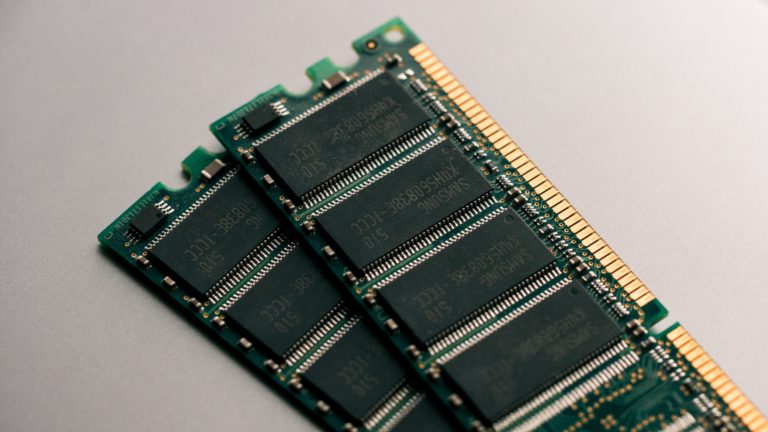What is Random Access Memory (RAM)?
When an operating system runs an application on your computer the data and machine code currently in use is loaded on a volatile memory chip/chips called RAM. RAM is also recognized popularly as a “Temporary Storage” or “Primary Memory” widely. The name “Random Access” refers to the fact that in such kind of a memory data can be fetched or written into the memory location by CPU in a similar amount of time irrespective of its physical location. The enabler for such a feature is a chip called a memory controller chip (MCC) through which the CPU achieves such privilege. At this stage, it is also important to understand that techie’s call this RAM as DRAM (Dynamic Random-Access Memory). As the technology has progressed in recent years computers have evolved from DRAM technology to SDRAM, RDRAMand DDR RAM.
DRAM manufacturers when the technology was fairly new placed a number of chips on a single stick and named it a single inline memory module (SIMM). Today RAM is installed on motherboards in memory sticks called as DIMM (Double inline memory module). In modern motherboards, one needs to find the right kind of memory stick which is compatible with it and information is generally available in the motherboard manual or on the motherboard manufacturer’s website. Most motherboards have 2 to 4 memory slots for installing RAM.
Types of RAM
There are many types of RAMs available in the market and they all may not be compatible with your motherboard. Check our “Concepts of RAM (Random Access Memory)” blog to know about all these different types of RAMs.
What will more RAM do to your PC?
When someone asks me for advice on how they can improve the performance of their PC. My first advice always is to check and upgrade your RAM if possible. It improves the overall performance of a PC or laptop. Besides, it helps reduce hiccups and improves data processing. Most commonly in-home PC’s insufficient RAM is the reason behind the poor performance of a PC as most people go by OS RAM requirement for their PC and underestimate the requirement of tens of applications they install on PC. It is important at this stage to discuss the concept of virtual memory to enable users to understand why it is so important to have a good amount of RAM on their PCs.
What is Virtual Memory?
When a computer is loaded with many applications parallelly and runs out of RAM it uses a portion of your hard disk drive as virtual memory. This part of your hard drive is called a page file or swap file and this is where your computer starts swapping the programs from RAM. Mac, Linux, and Windows all use virtual memory. We all know that HDD is very slow as compared to RAM hence this constant swapping of applications to and from virtual memory makes the system very slow. In most situations, this page file is created on the C:\ drive of computers and can be viewed for its size by enabling hidden system file function in Windows-based PCs. This is an automatic process managed by operating systems and no user intervention is sought to manage it by all operating systems.
Our system RAM recommendations for Windows based PC’s
- 32bit Windows: 2GB for operation; 4GB for optimum performance.
2. 64bit Windows: 4GB for operation; 8GB for optimum performance;16 GB for graphic/video intensive work.
Upgrading RAM in your PC
As discussed earlier how important it is for most computers to have RAM in adequate quantity for optimum performance, getting it done requires serious considerations. The secret to a successful RAM upgrade requires you to identify
- How much RAM currently is installed on the system and how much you need?
- What type of RAM is installed and is compatible with your motherboard?
- What is the maximum amount of RAM your motherboard can support?
To identify the amount and type of RAM you can have on your motherboard you can make use of many freely available online applications such as CPU-Z or RAMMOn. Alternatively, manuals that came with your motherboard and motherboard manufacturers’ websites are great sources as well. Once you have identified the right amount and type of RAM you can install it easily as your computer automatically detects and makes use of additional RAM available to it. This is being done using a technology called as SPD (Serial Presence Detect) which comes pre-installed on RAM sticks. SPD chip stores all information about your DRAM such as speed, bandwidth, ECC or Non-ECC, etc. When you boot up a computer system CPU gathers information from the CPD chip on knows exactly how much memory is on hand for MCC to utilize. Similarly, programs like CPU-Z and RAMMon can query SPD chips and present information to you through simple interactive applications.
How to troubleshoot RAM?
When your computer runs into problems related to RAM it shows them up in various ways such as system freeze, ECC error messages, and page faults. These errors sometimes indicate faulty RAM but can also relate to something else being wrong with your system. If you have an ECC RAM your system in such an event is likely to show “Parity Errors” with a chain of code such as Parity error at xxxx;xxxxx. Systems that do not have an ECC RAM can show up Phantom parity errors with different addresses, however, it is important to note that such errors can also be issued by OS because of hardware or application-related issues. System lockup happens when a computer starts functioning which sometimes indicates a bad RAM stick. Page fault errors can also be caused by defective RAM on your computer. Additionally, there is a panic button inside a PC which is called NMI (Non-Maskable Interrupt), and every once in a while it gets a push when something goes wrong. Your CPU can’t ignore NMI interruption and it displays the blue screen of death (BSOD) in Windows-based operating systems with error messages. In Mac OS a spinning rainbow wheel is displayed which is called a pinwheel of death. You can in such situations try and reboot the machine and check if the error continues to pop up. A bad RAM stick can cause NMI to trigger but most often it is found that the applications clashing due to wrong or clashing codes cause it.
Another solution you can think of is to replace the stick of RAM on your PC and it most certainly will resolve the problem related to RAM on your PC. With computer prices crashing in the market these days RAM sticks are pity cheap. Aren’t they? Thirdly there are many free memory diagnostic applications available online (such as Memtest 86+) that can diagnose issues with RAM but the limitation here is that they are being loaded into the RAM which is about to be scanned. Windows operating system7 and later versions also have a “Windows Memory Diagnostic Tool” which can be handy in such situations to report bad RAM if it finds one.
Terminologies associated with RAM
Latency
If you have purchased RAM recently in the market you could have come across a situation when you are comparing two memory sticks that have exactly the same label such as DDR3-2133 but one is faster than another. This is because RAMs may respond to MCC at varying speeds and there is in fact always a slight delay when RAM has supplied a line of code and another request appears from MCC for another line of code. Latency refers to this delay in response from RAM. RAM with lower latency is faster as compared to RAM with higher latency even when the product labels reflect the same bandwidth and frequency. With this logic, a RAM chip with CL6 latency will be fast compared to another RAM chip with CL9 latency as the CL6 latency chip will respond in 6 clock cycles whereas the CL9 latency chip will respond in 9 clock cycles. It must be noted that this logic is true only when we are comparing two RAM chips of the same bandwidth and frequency.
It may be noted that sometimes from a technical viewpoint if one inserts a high latency memory stick into a motherboard built for low latency stick you can get a dead or unstable PC.
Registered RAM Vs Non-Registered RAM
Buffered RAM or registered RAM refers to a small register installed on a memory module to act as a buffer between DIMM and MCC. Motherboards will take either of these types of RAM (Buffered or Unbuffered) and if you install the wrong type of stick on a motherboard at most it will show you a blank screen so no need to get annoyed when you are upgrading a PC.
- Microprocessors & associated terminology-All your questions answered!
- What is BYOD? Why is it trending among organizations around the world?
- What does no one tell you about Random-Access Memories?
- Difference between Passive Matrix and Active Matrix LCDs?
- Difference between Twisted Nematic (TN) and In-Plane Switching LCD technologies?
- All you want to know about Unshielded Twisted Pair (UTP) Cables!





